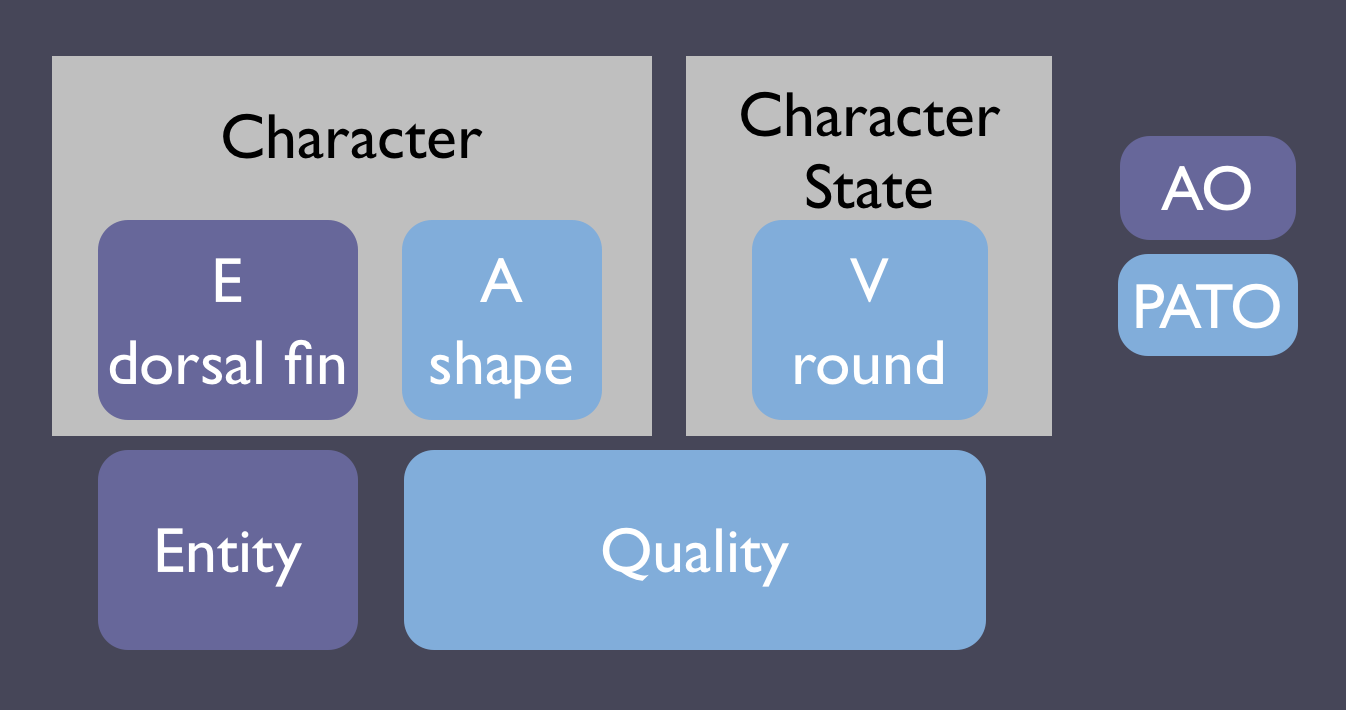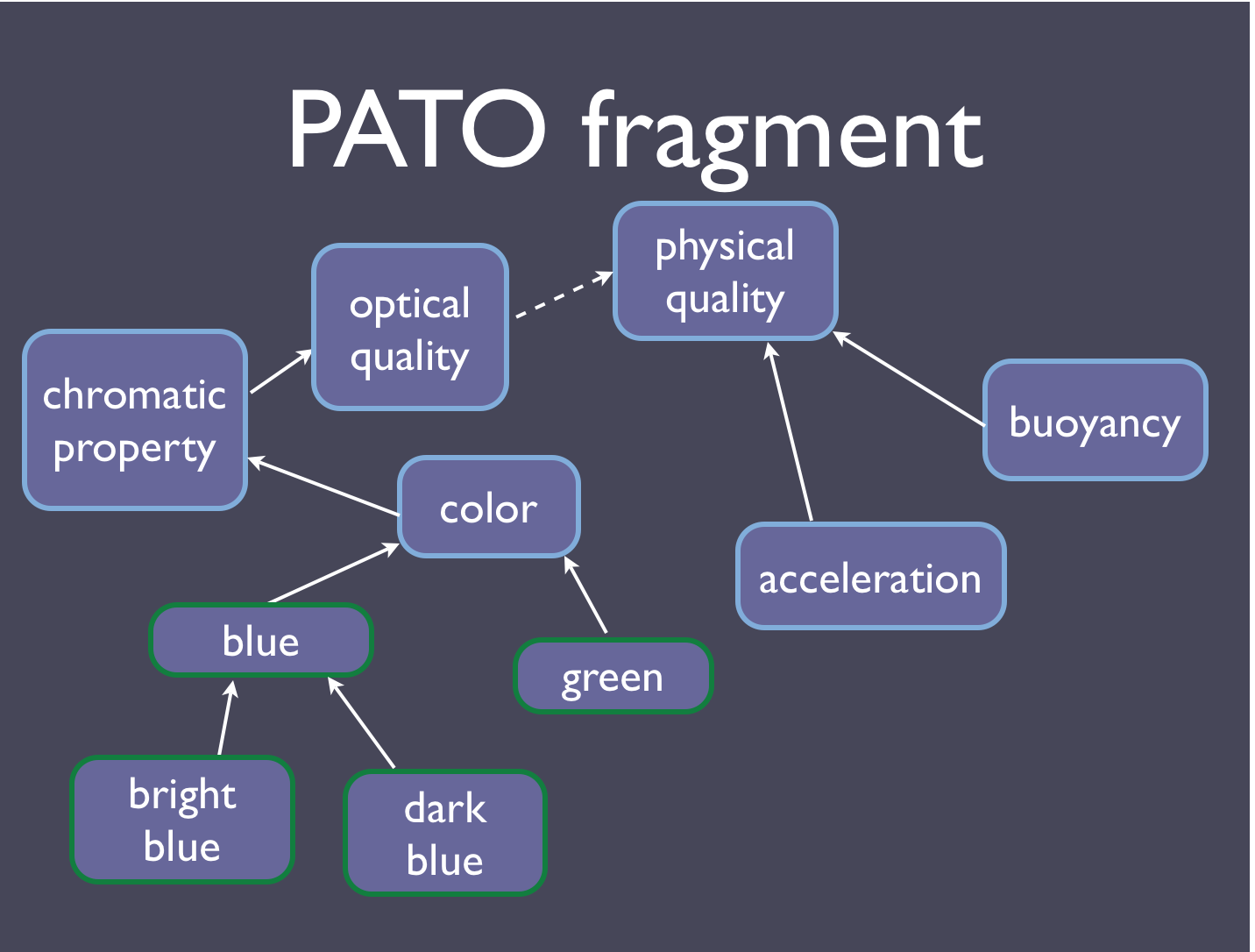Encoding evolutionary character matrices using the EQ format (PATO formalism) currently presents some problems that may need to be resolved. I will try to describe the issues here.
The EQ format provides a “phenotype statement” documenting the phenotype of an individual organism (usually a genetic mutant). The anatomical structure being described is represented by the Entity term chosen from an anatomical ontology, and the aspect of that structure being described is the Quality term, chosen from the PATO ontology. These phenotype statements usually describe the value the mutant exhibits:
E=”dorsal fin” Q=”round” –> This fish has a rounded dorsal fin.
Evolutionary phenotype descriptions are often formatted as a character matrix. For a given set of species, a list of distinguishing characters is formulated, and the species-specific value for each character is entered into the matrix. In this situation, each character (column in the matrix) represents an entity and attribute, and the character state cells contain values. Here is a graphical depiction of the relationship between evolutionary characters and the components of the EQ system:

The character (a column header in the matrix) is composed of an Entity, and a Quality representing an attribute (e.g. “shape”). Values for this character are entered into the cells (e.g. “round”). So you can see that the Q of EQ is represented in both the character and the character state. When EQ is used to describe mutant phenotypes, typically only the value is stated, since one can traverse back through the PATO hierarchy to find ancestor terms representing attributes - “round” is a child of “shape”.
Clearly, evolutionary characters and character states can be represented using an EQ system as mutant phenotypes are. However there is a major difference in the two data models: the data formats being developed for mutant phenotype EQ statements store only a list of phenotype value statements, with no place to reference an independent character. So you may have a data set like this:
| Genotype | Entity | Quality |
|---|---|---|
| fish1 | dorsal fin | round |
| fish2 | dorsal fin | lobate |
| fish2 | dorsal fin | red |
| fish1 | pectoral fin | blue |
If these fish are different species, you can see that there are 2 values for the character “dorsal fin shape”, 1 value for “dorsal fin color”, and 1 value for “pectoral fin color”. But nowhere in the existing EQ data formats is the character stored. We have to infer it from the PATO hierarchy to generate a matrix like this:
| Species | dorsal fin shape | dorsal fin color | pectoral fin color |
|---|---|---|---|
| fish1 | round | ? | blue |
| fish2 | lobate | red | ? |
So the problem is that the existing EQ system (and formats such as PhenoSyntax and PhenoXML) only stores a list of character states, and cannot group those states into characters. Storing only character states would be perfectly adequate for most of the data integration benefits provided by the PhenoScape project. However, evolutionary data is often described in the character+character state framework, and a few reasons why we may want to preserve this are listed below. Possible solutions to this problem for evolutionary data are: 1) Only storing character values and automatically generating characters when a matrix is desired, or 2) Finding a way to code and store EQ statements for both characters and character states.
PATO does not distinguish qualities representing values from those representing attributes, except that values descend from attributes in the hierarchy. But given an arbitrary value, it is not possible to automatically infer the attribute it is a value for. Many values are children of other values - for example, “bright blue” and “dark blue” are children of “blue”. You need to traverse up two levels to reach the attribute “color”. Also, some terminal terms in PATO are not values - they are attributes for which no values are defined in PATO. Examples are “acceleration” and “buoyancy”.

In order to automatically generate a character matrix from EQ data in Phenote, Attribute and Value slims were added to PATO. These slims are categories which are applied to each term in PATO, so that software can determine the use of each term. In the Phenote NEXUS-format exporter, the list of phenotype statements is grouped into characters based on whether they share a nearest common Attribute ancestor. Problems:
It would be possible to store EQ statements for both characters (Entity+Attribute) and character states (maybe just Value), either by defining a custom data format or by extending PhenoXML and PhenoSyntax. Probably, given a character such as “dorsal fin color”, valid values would only be PATO descendants of “color”, such as “red” or “bright blue”. However this approach may have some problems as well: